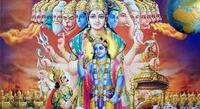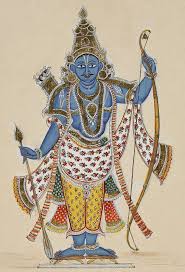Dwadasha stothra 3 : Verse 3
Nana swabhavam athyanta swabhavena vicharitham|
Aavishesha anadyantham pranamami sanathanam||3||
Nana swabhavam – Creation of various souls having different swabhavas. Bhagavantha creates and gives opportunity for different swabhavas to express and grow.
Bhagavantha himself has different swabhavas.
Bhava also means “avatara”. Bhagavantha has several avataras, but each of the avatara’s have same swaroopa and are not different from each other.
Atyanta swabena – The highest jeeva – brahma,Vaayu
Vicharitam – Guna chintane of bhagavantha by highest jeeva
Swabhena – swam – intimate person/ thing –highest jeevas do chintane of the most initimate thing to them ie Narayana.
Madhwacharyaru in mangalacharne of his all granthas says “ Preshta preshta tamayame” about narayana. Preshta – important, preshta preshta – most important, tama – very very important.
Nana swabhavamathyanta swabhavena vicharitham
Nana swabhavamathi – Jeevas having different swabhavas have different intellect.
Swabhavamathyanta – Brahma, Vaayu
Bhava also means bhakthi. “Bhavo bhaktir iti smruthaha” . Brahma and Vaayu worship Narayana by jeevaswabhava – which is bhakthi.
Aavishesham – There is no variation in gunakriyas of bhagavantha i.e. one guna is not more extolled than the other.
Illustration for aavishesham: Deepath deepantaram yatta: Using a lamp to light another lamp doesn’t decrease the intensity of first lamp.
Upanishad also says “Poornamadhaha poornamidham”: All avataras of Narayana are poorna, aavishesha.
Ana+adi+antham – Bhagavantha has no aadi and antha . The universe has a start and end, but bhagavantha is always present.
Ana – the source (paternity/origin) of universe – Pranadevaru
Sanathanam – Sana – always
BhagavadGita defines Sanathanam as “nathana sahitaa nadanava Santana” which means “Paramount Music” ( shrestavada nada) which are Vedas. Swami of all Vedas is Bhagavantha
Pranamami – worship with acknowledging all qualities of Narayana
BhagavadGita says “Adhibutham kshro abhavaha Swabhavo adyatamam ucchayate”
There are 4 tattvas –
- Adhibuta – AdibhUTa means relating to physical body, that which is within the ambit of physical body, actions using the physical bodies. “aDhibhUTa: ksharO bhAva:”, says the GITA, meaning “That which is physical is subject to depreciation”
- Adidaiva – Adidaiva means something which pertains to the system Brahman or SaT, the Infinitely powerful Existence. This is impartial and unbiased, in determining the destiny according to our own chosen actions. There is no escape. “Purushascha aDhiDaivaTam”, says the GITA, meaning, all that relate to the Purusha ( one who is stays in us as sentient).
- Adiyagna – Adhiyagna means that which relates to great actions for which we are embodied, so that our purpose is achieved. ‘adiyagna ahamEva’ says the GITA, meaning, the fundamental Existence whose system expects us to perform and get reward or punishment.
- Adyatama – spiritual science – non- perishable – relating to swabhava – swayam eva sada bhavati – swam – swantantra bhagavantha dinda bhavati- jeeva swaroopa – swabhava
3 gunas – sattva, rajas, tamas
There are different gradations of these gunas in each species and no two beings in any species have same gunas.



